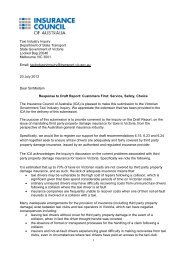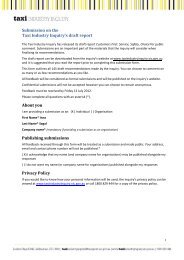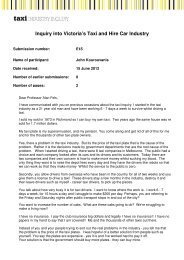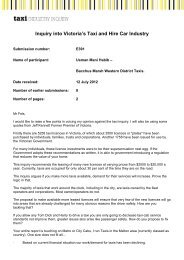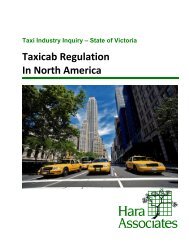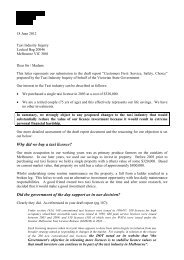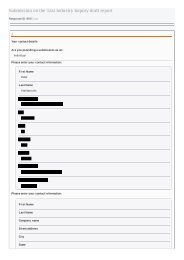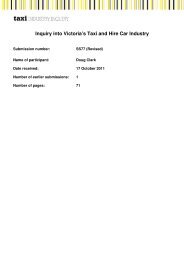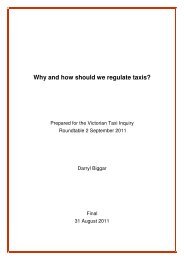Part D â Understanding and improving industry performance (PDF ...
Part D â Understanding and improving industry performance (PDF ...
Part D â Understanding and improving industry performance (PDF ...
Create successful ePaper yourself
Turn your PDF publications into a flip-book with our unique Google optimized e-Paper software.
Inquiry findings<br />
è Within the market for point-to-point transport<br />
services, there are important market segments<br />
for services acquired at ranks, hailed on the<br />
street or pre-booked.<br />
è There is significant overlap in the pre-booked<br />
segment between the services offered by taxis<br />
<strong>and</strong> hire cars, but regulations limit the degree<br />
of substitutability between different kinds of<br />
point-to-point transport services.<br />
è Public transport is only weakly substitutable<br />
for taxi travel, <strong>and</strong> in some cases may<br />
even be complementary. This implies that<br />
restrictions preventing taxis <strong>and</strong> hire cars<br />
from offering route services reduces use<br />
of taxis but does not significantly increase<br />
use of public transport.<br />
è Geographic markets for services largely mirror<br />
zone restrictions, but there are some instances<br />
where zones are drawn that may not be<br />
reflective of substitution possibilities.<br />
10.1.4. The nature of competition in taxi<br />
<strong>and</strong> hire car markets<br />
Some unusual features of markets for taxi <strong>and</strong> hire<br />
car services, particularly in the rank <strong>and</strong> hail market<br />
segments, can cause problems with the operation<br />
of competition. As discussed in chapter 7, market<br />
failures can arise in the sense that competition between<br />
operators does not produce the kind of outcomes that<br />
would benefit the community generally.<br />
How some of these features have developed is unclear.<br />
Notions of ‘fairness for drivers’ <strong>and</strong> ‘market order’ are<br />
likely to have been behind some of these features. In<br />
some cases, regulation has entrenched these market<br />
behaviours, making competition less likely rather than<br />
more likely. It is important to underst<strong>and</strong> these issues if<br />
changes to regulation are to make a contribution to a<br />
more competitive <strong>and</strong> more efficient market which better<br />
services consumer’s needs.<br />
Some of these key features are:<br />
• There is a convention that customers will take the<br />
first taxi off a rank, even though by law consumers<br />
have explicit rights to choose any taxi off the rank.<br />
This means that taxi operators do not compete for<br />
customers in rank <strong>and</strong> hail situations. This means that<br />
there is simply no point in competing by offering lower<br />
fares, as this will result in no more sales. Equally, there<br />
is no point in <strong>improving</strong> quality to try <strong>and</strong> differentiate<br />
services if all that does is increase costs (because<br />
consumers are unlikely to choose a higher quality<br />
vehicle from the rank).<br />
• Rather than competing for customers, taxi<br />
operators compete for drivers. Operators must<br />
offer drivers a package of services (including<br />
a vehicle) that makes it worthwhile for drivers<br />
to drive. The intensity of this competition has<br />
sometimes been questioned, particularly when<br />
there is a large supply of available drivers but,<br />
at the present time, the inquiry has heard that<br />
competition between operators for drivers is strong.<br />
• Booking networks compete to attract bookings from<br />
customers. These bookings are distributed to vehicles<br />
using criteria related to waiting time for the driver <strong>and</strong>/<br />
or the location of the driver. Customers have only<br />
limited ability to request particular taxi operators,<br />
vehicles or drivers. 6 Again, this limits the ability of<br />
operators to compete with one another on the basis<br />
of fare or driver <strong>and</strong> vehicle quality. Any vehicle of any<br />
quality (above a regulated minimum st<strong>and</strong>ard) can get<br />
fares by simply waiting long enough or in the right spot.<br />
These market features have a profound influence on<br />
market <strong>performance</strong>. Rather than operators having<br />
incentive to build their customer base by offering<br />
better service <strong>and</strong> lower prices – as could be expected<br />
in competitive markets – taxi operators face strong<br />
incentives to ‘skimp’ on service quality. Where reducing<br />
quality saves costs, there is little disincentive to do so<br />
(again, regulation also has a role to play in preventing<br />
services falling below some minimum st<strong>and</strong>ard). This<br />
affects vehicle st<strong>and</strong>ards, but – <strong>and</strong> perhaps more<br />
importantly – it also affects the kinds of drivers to<br />
whom operators bail their vehicles. These predicted<br />
outcomes have been borne out in the inquiry’s research<br />
on consumer experiences with taxis, particularly in the<br />
metropolitan Melbourne area.<br />
6 Customers can request a wheelchair accessible taxi (WAT) (or not<br />
a WAT) or vehicles with luggage capacity. Both major metropolitan<br />
NSPs have recently introduced ‘premium’ driver services, where<br />
customers can request a particular driver or a premium vehicle for an<br />
additional fee<br />
180





